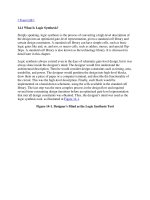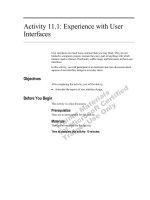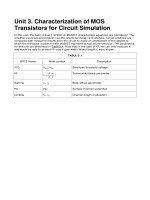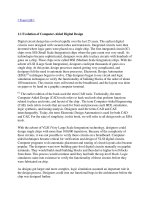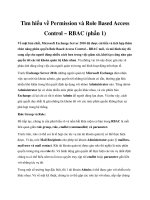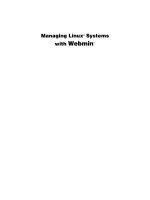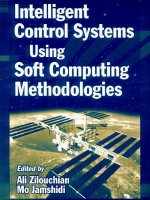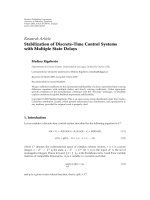Intelligent Control Systems with LabVIEW 1 doc
Bạn đang xem bản rút gọn của tài liệu. Xem và tải ngay bản đầy đủ của tài liệu tại đây (380 KB, 23 trang )
Intelligent Control Systems with LabVIEW™
Pedro Ponce-Cruz • Fernando D. Ramírez-Figueroa
Intelligent Control Systems
with LabVIEW™
123
Pedro Ponce-Cruz, Dr Ing.
Fernando D. Ramírez-Figueroa, Research Assistant to Doctor Ponce
Instituto Tecnológico de Estudios Superiores de Monterrey
Campus Ciudad de México
Calle del Puente 222
Col. Ejidos de Huipulco Tlalpan
14380, México, D.F.
México
ISBN 978-1-84882-683-0 e-ISBN 978-1-84882-684-7
DOI 10.1007/978-1-84882-684-7
Springer London Dordrecht Heidelberg Ne wYork
British Library Cataloguing in Publication Data
A catalogue record for this book is a vailable from the British Library
Library of Congress Control Number: 2009933628
© Springer-Verlag London L i mited 2010
BASIC Stamp
®
is a federally registered trademark of Parallax Inc. Parallax™ and Ping)))™ are trade-
marks of Parallax Inc.,
Bluetooth
®
word mark is owned by the Bluetooth SIG, Inc. h ttp://www.bluetooth.com
EmbeddedBlue™ is a trademark of A7 Engineering, Inc.
NI refers to National Instruments and all of its subsidiaries, business units, and divisions worldwide.
LabVIEW™ is a trademark of National Instruments. This book is an independent publication. National
Instruments is not affiliated with the publisher or the author, and does not authorize, sponsor, endorse or
approve this book. National Instruments Corporation, 11500 N Mopac Expwy, Austin, TX 78759-3504,
U.S.A. http://w ww.ni.com
Apart from any fair dealing for the purposes of research or private study, or criticism or revie w, as per-
mitted under the Copyright, Designs and Patents Act 1988, this publication may only be reproduced,
stored or transmitted, in any form or by a ny means, with the prior permission in writing of the publish-
ers, or in the case of reprographic reproduction in accordance with the terms of licenses issued by the
Copyright Licensing Agency. Enquiries concerning reproduction outside those terms should be sent to
the publishers.
The use of registered names, trademarks, etc., in this publication does not imply, even in the absence of
a specific statement, that such names are exempt from the relevant laws and regulations and therefore
free for general use.
The publisher m akes no representation, express or implied, with regard to the accuracy of the information
contained in this book and cannot accept any legal responsibility or liability for any errors or omissions
that may be made.
The publisher and the authors accept no legal responsibility for any damage caused by improper use of
the instructions and programs contained in this book and the DVD. Although the software has been tested
with extreme care, errors in the softw are cannot be excluded.
Cover design: eStudio Calamar, Figueres/Berlin
Printed on acid-free paper
Springer is part of Springer Science+Business Media (www.springer.com)
This book is dedicated to my mother and son with love.
Pedro Ponce
To my parents Virginia and Fernando because this would not be possible without
their unconditional love and support, and to my advisor and friend, Pedro for giving
me the opportunity to prove myself, and to all those who have accompanied me
along this wonderful journey of knowledge and creation.
David Ramirez
Preface
Control systems are becoming more important every day. At the beginning, the in-
dustry used sequential controls for solving a lot of industrial applications in control
systems, and then the linear systems gave us a huge increase in applying automatic
linear control on industrial application. One of the most recent methods for control-
ling industrial applications is intelligent control, which is based on human behavior
or concerning natural process.
Nowadays, the topic of intelligent co ntrol systems has become more than a re-
search subject to the industry. The number of industrial applications is growing ev-
ery day, faster and faster. Thus, new software and hardware platforms are required
in order to design and develop intelligent control systems. The challenge for these
types of systems is to have a novel platform, which allows designing, testing and im-
plementing an intelligent controller system in a short period of time. For the industry
and academy, LabVIEW™ is one of the most important software platforms for de-
veloping engineering applications and could be connected with different hardware
systems, as well as running standalone programs for simulating the controller’s per-
formance (validating the controller by simulation then implementing it). In addition,
LabVIEW is a graphical program that is very easy to learn.
Taking into account these advantages, the software platform described in this
book is LabVIEW from National Instruments™. The book is divided into 7 chapters
and gives all the information required for designing and implementing an intelligent
controller.
Chapter 1 provides an introduction to basic intelligent control concepts and con-
cludes by applying LabVIEW for implementing control systems. Chapter 2 covers
in deep d e tail the fuzzy logic theory and implementation. This chapter starts with
fundamental fuzzy logic theory for supporting the most important fuzzy logic con-
trollers implemented using LabVIEW.
Chapter 3 deals with artificial neural networks. In this chapter a complete set
of tools for implementing artificial neural networks is presented. Basic examples
of neural networks, such as perceptron, allow the students to understand the most
important topologies in artificial neural networks for modeling and controlling sys-
tems. In Chap. 4 the reader can find neuro-fuzzy controllers, which combine the
vii
viii Preface
fuzzy inference systems with an artificial neural network topology. Thus, the neuro-
fuzzy controllers are an interesting option f or modeling and controlling industrial
applications. Chapter 5 discusses genetic algorithms, which are representations of
the natural selection process. This chapter also examines how generic a lgorithms
can be used as optimization methods. Genetic programming is also explained in
detail.
Chapters 6 and 7 show different algorithms for optimizing and predicting that
could be combined with the conventional intelligent system methodologies pre-
sented in the p revious chapters such as fuzzy logic, artificial neural networks and
neuro-fuzzy systems. The methods presented in Chaps. 6 and 7 are: simulated an-
nealing, fuzzy clu stering means, partition coefficients, tabu search and predictors.
Supplemental materials supporting the book are available in the companion
DVD. The DVD includes all the LabVIEW programs (VIs) presented inside the
book for intelligent control systems.
This book would never have been possible without the help of remarkable people
who believed in this project. I am not able to acknowledge all of them here, but I
would like to thank Eloisa Acha, Gustavo Valdes, Jeannie Falcon, Javier Gutierrez
and others at National Instruments for helping us to develop a better book.
Finally, I would like to thank the Instituto Tecnológico de Monterrey campus
Ciudad de México for supporting this research project. I wish to remember all my
friends and colleagues who gave me support during this research journey.
ITESM-CCM Dr. Pedro Ponce-Cruz
México City
Contents
1 Intelligent Control for LabVIEW 1
1.1 Introduction . . 1
1.2 Intelligent Control in Industrial Applications . . . . 3
1.3 LabVIEW 4
References 7
2 Fuzzy Logic 9
2.1 Introduction . . 9
2.2 Industrial Applications . . 9
2.3 Background . . 10
2.3.1 UncertaintyinInformation 11
2.3.2 ConceptofFuzziness 11
2.4 Foundations of Fuzzy Set Theory . . . 11
2.4.1 FuzzySets 12
2.4.2 BooleanOperationsandTerms 14
2.4.3 FuzzyOperationsandTerms 15
2.4.4 PropertiesofFuzzySets 18
2.4.5 Fuzzification 18
2.4.6 ExtensionPrinciple 21
2.4.7 AlphaCuts 23
2.4.8 TheResolutionPrinciple 24
2.4.9 FuzzinessofUncertainty 24
2.4.10 Possibility and Probability Theories . 25
2.5 FuzzyLogicTheory 26
2.5.1 FromClassicaltoFuzzyLogic 26
2.5.2 FuzzyLogicandApproximateReasoning 26
2.5.3 FuzzyRelations 28
2.5.4 PropertiesofRelations 28
2.5.5 Max–Min Composition 29
2.5.6 Max–Star Composition 30
2.5.7 Max–Average Composition . . 31
ix
x Contents
2.6 Fuzzy Linguistic Descriptions 31
2.7 TheFuzzyLogicController 33
2.7.1 Linguistic Variables . . 33
2.7.2 MembershipFunctions 33
2.7.3 RulesEvaluation 33
2.7.4 MamdaniFuzzyController 34
2.7.5 Structure 34
2.7.6 Fuzzification 34
2.7.7 RulesEvaluation 35
2.7.8 Defuzzification 35
2.7.9 TsukamotoFuzzyController 35
2.7.10 Takagi–SugenoFuzzyController 36
2.7.11 Structure 36
2.7.12 Fuzzification 36
2.7.13 RulesEvaluation 36
2.7.14 CrispOutputs 37
2.8 Implementation of the Fuzzy Logic Controllers
Using the Intelligent Control Toolkit for LabVIEW . . 37
2.8.1 Fuzzification 38
2.8.2 RulesEvaluation 40
2.8.3 Defuzzification:CrispOutputs 41
2.9 ClassicalControlExample 43
References 46
FutherReading 46
3 Artificial Neural Networks 47
3.1 Introduction 47
3.2 ArtificialNeuralNetworkClassification 55
3.3 ArtificialNeuralNetworks 56
3.3.1 Perceptron 57
3.3.2 Multi-layer Neural Network 60
3.3.3 Trigonometric Neural Networks . . 71
3.3.4 Kohonen Maps . 79
3.3.5 BayesianorBeliefNetworks 84
References 87
FutherReading 88
4 Neuro-fuzzy Controller Theory and Applicatio n 89
4.1 Introduction 89
4.2 TheNeuro-fuzzyController 90
4.2.1 Trigonometric Artificial Neural Networks . . . . 91
4.2.2 FuzzyClusterMeans 96
4.2.3 PredictiveMethod 98
4.2.4 ResultsUsingtheController 100
4.2.5 ControllerEnhancements 101
Contents xi
4.3 ANFIS:AdaptiveNeuro-fuzzyInferenceSystems 106
4.3.1 ANFIS Topology 108
References 122
FutherReading 122
5 Genetic Algorithms and Genetic Programming 123
5.1 Introduction . . 123
5.1.1 EvolutionaryComputation 123
5.2 Industrial Applications . . 124
5.3 BiologicalTerminology 125
5.3.1 Search Spaces and Fitness . . . 125
5.3.2 EncodingandDecoding 125
5.4 GeneticAlgorithmStages 126
5.4.1 Initialization 127
5.4.2 Selection 128
5.4.3 Crossover 129
5.4.4 Mutation 130
5.5 Genetic Algorithms and Traditional Search Methods . . 134
5.6 ApplicationsofGeneticAlgorithms 135
5.7 ProsandConsofGeneticAlgorithms 136
5.8 Selecting Genetic Algorithm Methods 136
5.9 MessyGeneticAlgorithm 137
5.10 OptimizationofFuzzySystemsUsingGeneticAlgorithms 138
5.10.1 Coding Whole Fuzzy Partitions . . . 138
5.10.2 StandardFitnessFunctions 139
5.10.3 CodingRuleBases 139
5.11 An Application of the ICTL for the Optimization
of a Navigation System for Mobile Robots 140
5.12 Genetic Programming Background . . 143
5.12.1 Genetic Programming Definition . . 143
5.12.2 Historical Background . 144
5.13 Industrial Applications . . 144
5.14 AdvantagesofEvolutionaryAlgorithms 144
5.15 GeneticProgrammingAlgorithm 145
5.15.1 Length 146
5.16 GeneticProgrammingStages 146
5.16.1 Initialization 146
5.16.2 Fitness 147
5.16.3 Selection 147
5.16.4 Crossover 147
5.16.5 Mutation 148
5.17 VariationsofGeneticProgramming 149
5.18 GeneticProgramminginDataModeling 150
5.19 GeneticProgrammingUsingtheICTL 150
xii Contents
References 153
FutherReading 154
6 Simulated Annealing, FCM, Partition Coefficients and Tabu Search . 155
6.1 Introduction 155
6.1.1 Introduction to Simulated Annealing . . . 156
6.1.2 Pattern Recognition . . 157
6.1.3 Introduction to Tabu Search 157
6.1.4 Industrial Applications of Simulated Annealing . . . . 158
6.1.5 Industrial Applications of Fuzzy Clustering . . 158
6.1.6 Industrial Applications of Tabu Search . 158
6.2 SimulatedAnnealing 159
6.2.1 SimulatedAnnealingAlgorithm 161
6.2.2 SampleIterationExample 163
6.2.3 Example of Simulated Annealing
Using the Intelligent Control Toolkit for LabVIEW 163
6.3 FuzzyClusteringMeans 166
6.4 FCMExample 170
6.5 Partition Coefficients. . . 172
6.6 Reactive Tabu Search . . 173
6.6.1 Introduction to Reactive Tabu Search . . . 173
6.6.2 Memory 174
References 189
FutherReading 190
7Predictors 191
7.1 Introduction to Forecasting . . 191
7.2 Industrial Applications . 192
7.3 Forecasting Methods . . . 193
7.3.1 Qualitative Methods . . 193
7.3.2 Quantitative Methods 194
7.4 RegressionAnalysis 194
7.5 Exponential Smoothing 194
7.5.1 Simple-exponential Smoothing . . . 195
7.5.2 Simple-exponential Smoothing Algorithm . . . 195
7.5.3 Double-exponential Smoothing . . 196
7.5.4 Holt–WinterMethod 197
7.5.5 Non-seasonal Box–Jenkins Models 198
7.5.6 General Box–Jenkins Model . 199
7.6 MinimumVarianceEstimationandControl 200
7.7 Example of Predictors Using the Intelligent Control Toolkit
forLabVIEW(ICTL) 202
7.7.1 Exponential Smoothing 202
7.7.2 Box–Jenkins Method . 203
7.7.3 MinimumVariance 204
Contents xiii
7.8 GrayModelingandPrediction 205
7.8.1 ModelingProcedureoftheGraySystem 206
7.9 ExampleofaGrayPredictorUsingtheICTL 207
References 210
FutherReading 210
Index 211
Chapter 1
Intelligent Control for LabVIEW
1.1 Intr oduction
Intelligent control techniques that emulate characteristics of biological systems of-
fer opportunities for creating control products with new capabilities. In today’s com-
petitive economic environment, these control techniques can provide products with
the all-important competitive edge that companies seek. However, while nu merous
applications of intelligent control (IC) have been described in the literature, few ad-
vance past the simulation stage to become laboratory prototypes, and only a handful
make their way into products. The ability of research to impact products hinges not
so much on finding the best solution to a problem, but on finding the right problem
and then solving it in a marketable way [1].
The study of intelligent control systems requires both defining some important
expressions that clarify these systems, and also understanding the desired applica-
tion goals. The following definitions show the considerab le challenges facing the
development of intelligent control systems.
Intelligence is a mental quality that consists of the abilities to learn from expe-
rience, adapt to new situations, understand and handle abstract concepts, and use
knowledge to manipulate one’s environment [2]. We can define artificial intelli-
gence as the ability of a digital computer or computer-controlled robot to perform
tasks com monly associated with intelligent beings [2].
Thus, IC is designed to seek control methods that provide a level of intelligence
and autonomy in the control decision that allows for improving the system perfor-
mance. As a consequence, IC has been one of the fastest growing areas in the field of
control systems over the last 10 years. Even though IC is a relatively new technique,
a huge number of industrial applications have been developed. IC has different tools
for emulating the biological behavior that could solve problems as human beings
do. The main tools for IC are presented below:
• Fuzzy logic systems are based on the experience of a human operator, expressed
in a linguistic form (normally IF–THEN rules).
P. Ponce-Cruz, F. D. Ramirez-Figueroa, Intelligent Control Systems with LabVIEW™ 1
© Springer 2010
2 1 Intelligent Control for LabVIEW
• Artificial neural networks emulate the learning process of biologic neural net-
works, so that the network can learn different patterns using a training method,
supervised or unsupervised.
• Evolutionary methods are based on evolutionary processes such as natural evo-
lution. These are essentially optimization procedures.
• Predictive methods are mathematical methods that provide information about the
future system behavior.
Each one has advantages and disadvantages, but some of the disadvantages can be
decreased by combining two or more methods to produce one system (hybrid sys-
tems). As an example, in the case of fuzzy logic, we can combine this method with
neural networks to obtain a neuro-fuzzy system. For instance, the adaptive neural-
based fuzzy inference system (ANFIS) was proposed in order to utilize the best part
of fuzzy logic inference using an adaptive neural network topology [3].
Different authors have presented many hybrid systems, but the most important
and useful combinations are [4]:
• Neural networks combined with genetic algorithms [5].
• Fuzzy systems combined with genetic algorithms [6].
• Fuzzy systems combined with neural networks [7].
• Various other combinations have been implemented [8, 9].
Since fuzzy logic was first presented by Prof. Lotfi A. Zadeh, the number of fuzzy
logic control applications has increased dramatically. For example, in a conven-
tional proportional, integral, and differential (PID) controller, what is modeled is
the system or process being controlled, whereas in a fuzzy logic controller (FLC),
the focus is the human operator’s behavior. In the PID, the system is modeled ana-
lytically by a set of differential equations, and their solution tells the PID controller
how to adjust the system’s control parameters for each type of behavior required.
In the fuzzy controller, these adjustments are handled by a fuzzy rule-based expert
system, a logical model of the thinking processes a person might go through in the
course of manipulating the system. This shift in focus from the process to the person
involved changing the entire approach to automatic control problems [10].
The search has been ongoing for a controller, of a black box type, which can be
simply plugged into a plant, where control is desired; thus, the controller takes over
from there and sorts everything else out [10].
IC is a good solution for processes where the mathematical model that describes
the system is known only partially. In fact, the PID controller is one of the most
functional solutions used nowadays, because it requires a very short time for im-
plementation and the tuning techniques are well known. We show in this book how
fuzzy systems can be used to tune direct and adaptive fuzzy controllers, as well as,
how these systems can be used in supervisory control.
Although the IC is more complex in structure than the PID controller, the IC
gives a better response if the system changes to a different operation point. It is well
known that linear systems are designed for working around the operation point. In
the case of IC, we will be able to design controllers that work outside the opera-
1.2 Intelligent Control in Industrial Applications 3
Fig. 1.1 Basic sets for
obtaining IC systems
tion point. A global position in control theory of IC is shown in Fig. 1.1, in which
different sets intersect in the IC area.
As it is presented, IC systems are in contrast to analytical control, because soft
computing methodologies mimic consciousness and cognition in several important
ways:
• To learn from experience.
• To be able to universalize into domains where direct experience is absent.
• To run into parallel computer architectures, which simulate biological processes.
• To perform mapping from inputs to the outputs faster than inherently serial ana-
lytical representations.
The trade off, however, is a decrease in accuracy. If a tendency towards imprecision
can be tolerated, then it should be possible to expand the range of the applications
even to those problems where the analytical and mathematical representations are
readily available [11].
1.2 Intelligent Control in Industrial Applications
The number of industrial applications that use IC systems is rapidly increasing,
where one can find IC systems in both large and small industrial applications. An-
other growing area of IC applications is developing household appliances, which
are small but complex control systems. Many systems that use fuzzy logic or n eu-
ral networks for control apply these techniques to solve problems that fall outside
the domain o f conventional feedback control, e. g., in the case of a washer ma-
chine it is easier to control the duty cycle by a FLC than a PID controller. When
we view fuzzy or neural control as only a non-linear counterpart of conventional
feedback control techniques, the possibilities of using IC are reduced. Thus, a nar-
row conceptual view of IC system application leads to designers not appreciating or
recognizing new areas of opportunities. If you use only the IC systems as a conven-
tional controller the difference is quite small. For instance, using a FLC as a PID
4 1 Intelligent Control for LabVIEW
controller with the error and the change in error as inputs, the fuzzy controllers
look similar to the conventional PID controller except that fuzzy control provides
a non-linear control law. Another case is the use of a neural network applied to the
set-point regulation problem, usually by replacing a conventional controller’s law
and/or plant model with an artificial neural network. However, if we apply IC sys-
tems to standard and non-standard techniques we could handle high-level control
systems. Let us imagine the control system of the train developed in Sendai, Japan
by Hitachi. Here fuzzy logic was used to select the notch position that will best sat-
isfy the multiple, often-conflicting objectives. An additional example is that many
Japanese companies such as Matsushita, Sanyo, Hitachi, and Sharp, h ave incorpo-
rated n eural network technology into a product known as the kerosene fan heater.
In Sanyo’s heater, a neural network learns the daily usage pattern of the consumer,
thus allowing the heater to automatically start to preheat in advance [12]. For many
industrial applications one could complement the conventional controllers by an in-
telligent controller generating a new one, rather than using IC alone. The industrial
challenge is focused on developing control systems that are capable of adapting to
rapidly changing environments and on improving their performance based on their
experience. In other words, modern control systems are being developed that are
capable of learning to improve their performance over time (to learn) much like
humans do [4].
1.3 LabVIEW
LabVIEW is a graphical control, test, and measurement environment development
package. Laboratory Virtual Instrument Engineering Workbench (LabVIEW) is
a graphical programming language that uses icons instead of lines of text to create
programs. It is one of the most widely used software packages for test, measure-
ment, and control in a variety of industries. LabVIEW was first launched in 1986,
but has continued to evolve and extend into targets seemingly out of reach before
for such packages, including field programmable gate arrays (FPGAs), sensors, mi-
crocontrollers and other embedded devices. The introduction of the express virtual
instruments (VIs) allow designers faster and easier development of block diagrams
for any type of data acquisition, analysis, and control application. As a result, Lab-
VIEW simplifies the scientific computation, process control, research, industrial ap-
plication an d measurement applications, since it has the flexibility of a programming
language combined with built-in tools designed specifically for test, measurement,
and control. By using the integrated LabVIEW environment, it is now easier to in-
terface with real-world signals, analyze data for meaningful information, and share
results [13,14].
As we know, there are numerous programs on the market for controlling, analyz-
ing, and processing signals but LabVIEW has a big advantage in its graphical user
interface (GUI). LabVIEW was preferred over other programs by a wide margin for
its easy-to-use GUI capabilities. This feature is an integral part of the LabVIEW
1.3 LabVIEW 5
Fig. 1.2 Block diagram from Intelligent Control Toolkit
VI structure for code development. The other two criteria for which LabVIEW was
slightly preferred included its easier-to-use real-time integration tools and help re -
sources [14]. These advantages were taken into account for selecting LabVIEW as
the main platform in the Intelligent Control Toolkit design. Thus, all of the material
presented in this book was generated by VIs, which are the basic programs in Lab-
VIEW [13]. “Ever since LabVIEW shippe d, it had more recog nition than NI,” said
Kodosky who is one of the founders of National Instruments [13].
The progr ams that simulate virtual instruments created in LabVIEW are called
VIs. The VI has three basic components: the front panel, the block diagram, and
the icon connector. The control panel is the user interface and the code is inside the
block diagram that contains the g raphical code. Also, one could include a subVI
that must have an icon and a connector pane, where the subVI is generated as a VI.
Figures 1.2 and 1.3 show the block diagram and the front panel from a VI example
of the Intelligent Control Toolkit [15].
In the front panel, one can add the number of inputs and outputs that the system
requires. The basic elements inside the front panel can be classified by controls and
indicators. The general type of numerical data can be integers, floating, and complex
numbers. Another type of data is the Boolean, useful in conditional systems (true
or false), as well as strings, which are a sequence of ASCII characters that give
a platform-independent format for information and data [16].
Using control loops, it is possible to repeat a sequence of programs or to enter the
program conditions. The control loops used are shown in Fig. 1.4. It is also possible
to analyze the outputs of the intelligent systems by a waveform chart or other block,
by plotting the output data. Figure 1.5 shows a waveform chart used for analyzing
output signals.
In the case of inputs, which are representations of physical phenomenon, one
could obtain the information by a data acquisition system. One of the main goals
in the data acquisition system for obtaining a successful system is the selection of
the system, as well as, the transducer and sensors. The data acquisition system plays
6 1 Intelligent Control for LabVIEW
Fig. 1.3 Front panel. Adapted
from [15]
Fig. 1.4 Control block loops
a key role in the control system design. Nowadays National Instruments is one of the
most important companies in the world for providing excellent acquisition systems.
Different acquisition systems are shown in Fig. 1.6.
References 7
Fig. 1.5 Waveform chart
Fig. 1.6a,b Acquisition systems developed by NI [16]. a CompactRIO™. b NI USB DAQ
References
1. Chiu S (1997) Developing commercial applications of intelligent control. IEEE Control Syst
Mag 17(2):94–100
2. Encyclopedia Britannica (2009) Intelligence. />289766/human-intelligence. Accessed on 22 March 2009
3. Jang J-SR (1993) ANFIS: Adaptive network-based fuzzy inference systems. IEEE Trans Syst
Man Cybernet 23:665–685
8 1 Intelligent Control for LabVIEW
4. Karr CL (2003) Control of a phosphate processing plant via a synergistic architecture. Eng
Appl Artif Intell 6(1):21–30
5. Van Rooij AJF (1996) Neural network training using genetic algorithms. World Scientific,
River Edge, NJ
6. Sanchez E, Shibata T, Zadeh LA (1997) Genetic algorithms and fuzzy logic systems. Ad-
vances in fuzzy systems: application and theory, Vol. 7. World Scientific, River Edge, NJ
7. Kosko B (1991) Neural networks and fuzzy systems: a dynamical systems approach to ma-
chine intelligence. Prentice Hall, New York
8. Goonatilake S, Khebbal S (eds) (1996) Intelligent hybrid systems. Wiley, New York
9. Medsker LR (1995) Hybrid intelligent systems. Kluwer, Dordrecht
10. Schwartz DG, Klir GJ (1992) Fuzzy logic flowers in Japan. IEEE Spectrum 29(7):32–35
11. Zilouchian A, Jamshidi M (2001) Intelligent control systems using soft computing method-
ologies. CRC, Boca Raton, FL
12. Warwick K (1998) Recent developments in intelligent control. IEE Colloquium on Updates
on Developments in Intelligent Control, Oct 1998, pp 1/1–1/4
13. Josifovska S (2003) The father of LabVIEW. IEE Rev 49(9): 30–33
14. Ke htarnavaz N, Gope C (2006) DSP system design using LabVIEW and Simulink: a com-
parative evaluation. Proceedings of IEEE International Conference on Acoustics, Speech and
Signal Processing (ICASSP), Toulouse, France, 14–19 May 2006, Vol. 2, pp II–II
15. ITESM Mexico (2007) Intelligent Control Toolkit for LabVIEW. US Patent Application
61/197,484
16. National Instruments (2009) . Accessed on 22 March 2009
